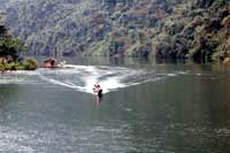As the birthplace of national icon Ho Chi Minh, Nghe An Province has been emblazoned in the consciousness of the Vietnamese people for several generations. But today it is attracting attention for a different reason - its potential for a great holiday.
 Forests, mountains and ethnic minority villages - there’s a lot to see in the province. But in particular there is Con Cuong Town in the west, home to Pu Mat National Park. This is a must-see tourist spot rich in biodiversity and stunning natural landscapes. The best vantage point to enjoy the scenery is along the Giang River and the best way to travel is by canoe.
Forests, mountains and ethnic minority villages - there’s a lot to see in the province. But in particular there is Con Cuong Town in the west, home to Pu Mat National Park. This is a must-see tourist spot rich in biodiversity and stunning natural landscapes. The best vantage point to enjoy the scenery is along the Giang River and the best way to travel is by canoe.
The 100km-long river hugs the peripheries of Pu Mat. This majestic stretch of water, sometimes calm, sometimes fierce, is a gift endowed by nature to this impoverished district. It’s also a top destination for the intrepid tourist.
To get there, we travelled more than 300 km from Ha Noi along the Ho Chi Minh Highway then over 40km down Highway 7 to get to the town. From there, we continued another 20km to the lower reaches of the river to visit Pha Lai Dam, the largest irrigational work in Con Cuong District. According to the language of the Thai ethnic people, Pha Lai translates as "flower of the sky".
From here, we hired a dug-out canoe and started our journey upstream.
Not for the faint-hearted
Although the river is not very deep, this trip is not for the faint hearted. In some parts there are rocky patches with powerful rapids so its best to keep your wits about you. Sometimes the water is so shallow you have to get out and carry the boat across the rocks. But it’s an excellent work out.
After paddling through the forest for a few hundred metres, we came across the first signs of civilisation - rafts of wood floating on the water. According to our guide, these belonged to local Dan Lai people, an ethnic minority who live a self-contained and primitive existence in the mountains around Con Cuong.
The Dan Lai live in wooden stilt houses with roofs made of palm leaves. As we passed by some of them, we decided to stop so we could have a chat with local people and learn about some of their customs.
We were greeted by an old man named Quyet who invited us to have a look inside his house. When we entered, we were surprised to see he didn’t have a bed. To our wonder, he said: "For thousands of years, the Dan Lai people have never slept on a bed, we sleep sitting by the cooking fire."
"This custom originated from early times," he said.
"Long ago, there were a lot of tigers in the area. If people were not constantly on alert, they could easily fall prey to these cunning predators. To protect themselves, people here devised a method of sleeping sitting up so they could get up quickly and run into the forest if anything happened."
Quyet said there were several ways people can sleep sitting up.
"One way is to support your head with your hands, or you can also use a wooden cane. Dan Lai women even give birth sitting up."
After our stop off, we were back on the water, absorbing the tranquility of the countryside. You really can’t beat the feeling of skimming along the water on a canoe.
Once through the rapids, there are stretches of water that are as flat as glass, and you can relax to soak in the view - huge trees whose branches swoop down towards the water, and patches of grassland appearing in the clearings. The foliage was alive with wild animals and in the quiet sections, we could hear their cries.
As for animals in the water, there is one creature that many fishermen would like to see up close. It is the mat fish, delicious, nutritious and very common in these waters.
Our trip took more than three hours to Co Phat Village, and cost us VND500,000 (US$28), but for another VND800,000 (US$45) you can head out to the upper reaches of the river and spend the whole day on the water. If you really want to make an adventure of it, it is also possible to ask the local Dan Lai people if you can stay at their house for an agreed price.
With the sights, smells and sounds of nature caressing you as you glide along, you have to admit there’s no better way to escape the stress of the city and get close to nature for a day.